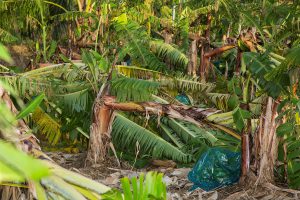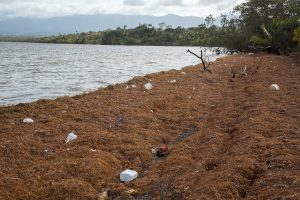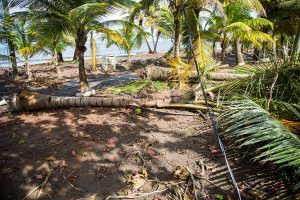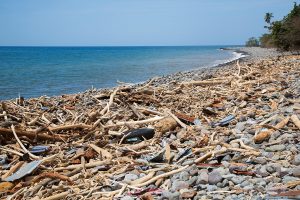Pointe-à-Pitre, Guadeloupe, Wednesday, September 20: Twenty-four hours after Hurricane Maria hit Guadeloupe
“I know what it’s like to ride out a hurricane, and I’ve done it every year since I was born. But this time, it’s different. The hurricanes are stronger and more frequent. We’re emotionally drained and we know that hurricane season isn’t over yet. Since September 10, two Category Five hurricanes’ Irma and Maria have hit the Antilles, causing massive destruction on Saint Martin and Dominica. As we stand at the reception desk of the waterfront hotel in Pointe-à-Pitre, the manager describes the situation to us, including the fact that there’s no running water or Wifi. Along with Race for Water’s land-based team, we’ll spend our first night in Guadeloupe in this hotel ; Race for Water is still out at sea, to avoid the worst of the hurricane. We’re all exhausted and we head to bed.
Pointe-à-Pitre, Guadeloupe, Thursday, September 21: The calm between storms
We get up at dawn and head toward the city to assess the damage. Although it looks like most buildings were spared, Maria’s wrath is clearly visible: the streets and sidewalks are blocked by downed trees and branches, and boats are washed up on the shore. The sky is the color of lead and the humidity is crushing. But all the same, we feel lucky when we think of the storm’s magnitude.

Before noon, Race for Water appears over the southern horizon. Franck, Luce, and Annabelle have been waiting for her, and they talk to the marina staff about finding a different mooring, since the violent winds caused some damage in the port. Aurélie is here with us to welcome Race for Water into port, and she’s thrilled to be able to get out of the house. “The government had asked us to stay indoors with enough food and water to last until the curfew was lifted.” She tells us about a hair-raising night, with wind gusts up to 200 kilometers an hour. But her house had no serious damage. “We were really lucky. But the western part of the island that we call Basse-Terre was hit much harder. The road to it is cut off,” she tells us.
By early afternoon, Race for Water is moored and we rush to greet the crew. They were able to chart a course around the massive storm, and conditions were relatively good. They’ve barely disembarked from the ship when they’re all asking, “How are conditions on the island? Was there a lot of damage?” To answer that question, we have to go to the hardest-hit area.

Basse-Terre, Guadeloupe, Saturday, September 22: Life gets back to normal
In order to understand the damage caused by the hurricane, and to study the plastics pollution that the storm caused, we leave at dawn for Basse-Terre, on the western side of the island. “It should be interesting to look at the mouths of the rivers and the beaches nearby, because trash always piles up there when it rains a lot,” says Peter Charaf, media coordinator for the Race for Water Foundation. We take a road through a dense forest, and the trees around us are completely shredded. It’s as if the wind came through like a buzz-saw, crushing entire swaths of vegetation as it passed. Along the coast, the roads and waterfront neighborhoods are littered with boulders, rocks, and sand. A resident in Trois-Rivières tells us, “Our houses are really well-built, and only ten roofs blew off.” The beaches are covered with driftwood and we see a few pieces of discarded plastic. There’s some pollution, but not much. A young man sits in front of his wooden hut holding a broom. He tells us, “In Bouillante, NGOs and local residents came to clean up the trash. We all want to preserve the oceans and we know that plastics waste is a problem.” This is good news for the Race for Water Foundation, and it shows the impact of regular beach cleanups. It’s only been a few days since a Category Five hurricane came through and the countryside is a mess. But life in Guadeloupe is beginning to get back to normal. It’s fortunate that the people of Guadeloupe are environmentally aware, but some neighboring islands aren’t so lucky.

